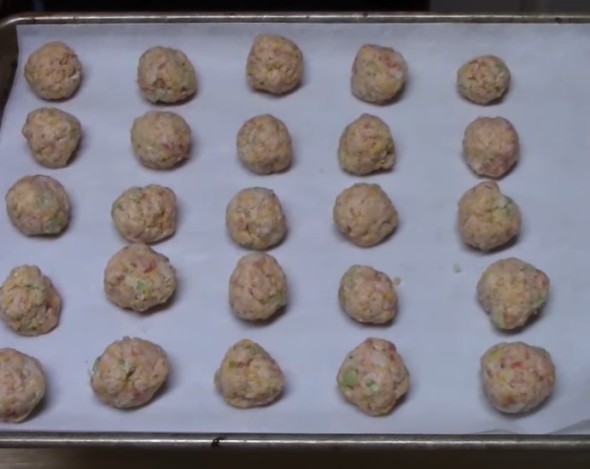Sausage balls are a crowd-pleasing treat that’s perfect for any occasion, from parties to game nights.
But, despite their popularity, making sausage balls can be challenging, especially when they turn out dry and crumbly.
So, what causes this issue?
In this guide, we’ll take a closer look at how to fix it and other common problems that you may encounter.
Table of Contents
Why Are Your Sausage Balls Too Dry?
There are a few reasons why they may end up dry and crumbly. Here are some details:
Low-Quality Ingredients: The cornerstone of excellent sausage balls is high-quality ingredients. If you opt for subpar ground sausage, baking mix, or cheese, your sausage balls may lack the necessary moisture, leaving them dry and bland. To ensure outstanding results, always choose top-tier ingredients.
Ingredient Ratio: Deviate from the recipe, and you risk throwing off the ingredient ratio, which can lead to dry sausage balls. Precision is key. Follow the recipe closely, using the correct measurements to achieve the desired texture and consistency.
Too Much Baking Mix: Adding an excessive amount of baking mix to your sausage ball mixture can overpower the moisture from the ground sausage, resulting in a dry outcome. The trick is to incorporate just enough baking mix to bind the ingredients together without drying them out.
Reheating: Reheating them multiple times can impact their taste and texture, draining them of moisture and leaving you with dry, unpalatable sausage balls.
Inconsistent Mixture: Inadequately combining dry and wet ingredients can result in sausage balls with dry pockets. Before forming the familiar peach-sized balls, ensure the mixture is well-blended to prevent dryness.
Pre-Shredded Cheese: Pre-shredded cheese can contribute to the dryness of your sausage balls. Opt for hand-grated cheese to infuse with the right amount of moisture, ensuring each bite is tender and chewy.
By understanding these common causes, you can take steps to adjust your recipe and techniques to produce moist and delicious sausage balls every time.
How to Moisturize Dry Sausage Balls
There are several ways to add moisture and restore their tenderness:
Adjust the Ingredient Ratio
If you’ve gone overboard with the baking mix, causing dryness, try adding a cup of water or milk to the mixture. You can also knead it until it reaches a uniform consistency, preventing dryness in the process.
Dilute the Mixture with Milk
Should you notice the mixture becoming too thick after adding the wet ingredients, simply dilute it with milk. To keep the recipe balanced and end up with a bigger batch that is wonderfully soft and supple, make sure to adjust the remaining ingredients accordingly.
Use Leaner Cuts of Meat
Even with added moisture, if your sausage balls remain dry, consider using leaner cuts of meat. These cuts release more moisture during baking, which is then absorbed by the baking mix, ensuring your sausage balls retain their signature tenderness.
Knead the mixture by Hand
When mixing the ingredients, employ the tactile approach of kneading by hand. This method fosters ingredient cohesion and eliminates any residual dryness. Make sure to have a glass of water handy so you can wet your hands as needed throughout the process.
Grate Cheese Yourself
Steer clear of pre-shredded cheese, often dryer and containing preservatives. Instead, grate the cheese by hand when preparing. This guarantees even distribution of cheese throughout the mixture, yielding chewier and softer sausage balls.
By following these tips, you can add moisture and restore the tenderness of your dry sausage balls. Remember to adjust the ingredient ratio carefully and choose high-quality ingredients to achieve the best results.
>>Also read: How to Cook Frozen Boudin Balls
Prevent Sausage Balls from Burning on the Bottom

Another way to prevent the bottom of the sausage balls from burning is to use a non-stick baking sheet or line the baking sheet with parchment paper.
The non-stick surface will help prevent the sausage balls from sticking to the sheet, reducing the chance of the bottom burning.
Additionally, if you’re using a dark-colored baking sheet, it can absorb more heat and lead to burnt bottoms.
Switch to a light-colored baking sheet or a glass baking dish to help distribute the heat more evenly and prevent the bottom from burning.
Finally, keep an eye on the baking time. Sausage balls typically take around 20-25 minutes to bake, but depending on the oven and the size of the balls, it may vary.
Check periodically, and when they’re golden brown on top and cooked through, take them out of the oven to prevent over-baking and burning.
Why Aren’t Your Sausage Balls Sticking Together?
The Role of Cheese
One of the most common reasons for sausage balls not sticking together is the type of cheese used. Many recipes call for pre-shredded cheese that is often jam-packed with cellulose to prevent clumping. While this may be convenient, it can lead to dryness and hinder the cheese from blending smoothly into the mixture.
Solution: To overcome this issue, it’s advisable to skip the pre-shredded cheese and opt for grating cheese strips yourself. Freshly grated cheese will meld seamlessly with other ingredients, ensuring a uniform and delicious result.
Balancing Bread Mix
Another crucial factor in preparation is the balance between the bread mix and the wet ingredients. Too much bread mix or biscuits can overpower the mixture, making it difficult for the balls to retain their round shape.
Solution: If you find that you’ve added an excess of bread mix, don’t fret. Simply dilute it by incorporating a cup of milk or water into the mixture. This will help strike the perfect balance.
Managing Moisture
Creating sausage balls with the ideal consistency is all about managing moisture effectively. If your mixture becomes too watery, it won’t hold together as desired, making it challenging to shape the balls.
Solution: The key here is to ensure that your mixture feels smooth to the touch but doesn’t appear watery. This can be achieved by gradually adding the wet ingredients while constantly assessing the texture. Striking this delicate balance will enable you to shape effortlessly.
Recipe Accuracy Matters
Nailing the recipe is paramount when it comes to making sausage balls that stick together perfectly. Each ingredient plays a crucial role in achieving the desired consistency and taste. Therefore, always double-check the recipe to ensure you’re using the perfect amount of ingredients.
Embracing Precision
Precision in measuring and incorporating ingredients is the secret to sausage ball success. Even a slight deviation from the recipe can lead to inconsistencies in your final product.
Solution: Invest in quality measuring tools to ensure accurate ingredient quantities. A kitchen scale can be a game-changer, allowing you to achieve precision in your cooking. Following the recipe to the letter is your ticket to perfection.
Final Thoughts
In summary, to ensure your sausage balls come out moist and tender, it’s crucial to get the balance of wet and dry ingredients right. Avoid adding too much baking mix and follow the recipe closely. Kneading the mixture until it’s evenly combined can also prevent dryness.
Use fresh, high-quality ingredients and grate your cheese instead of using pre-shredded cheese.
To prevent burning the bottom of your sausage balls, adjust the oven temperature and position the rack in the middle of the oven.
With these tips, you’ll be able to make perfectly moist and delicious sausage balls every time!
Sausage balls dry
Bisquick, bisquick sausage balls, sausage ball recipe, simple to make, large mixing bowl, like this recipe, pork sausage, shred, sharp cheddar, sharp cheddar cheese, appetizer, jimmy dean, shredded cheese, hot sausage, uncooked sausage, baking powder, pepper jack, sausage cheese, bisquick mix, freeze sausage, sausage cheese balls, breakfast sausage, make ahead, cream cheese, cookie scoop, much bisquick, made with bisquick, balls are always a hit, pepper jack cheese, balls and baked, shredded sharp cheddar cheese.

Fernando is the creator and writer behind the food blog Eating with your Hands. Living and working in cities like Paris, Barcelona, and Berlin, and being married to a Canadian foodie, has given Fernando a passion and interest in food and inspired him to run EWYH.

